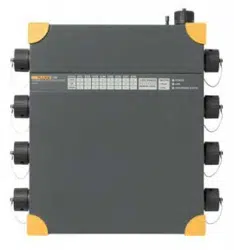Loading ...
Loading ...
Loading ...

1760
Users Manual
3-20
THD cap
THD cap is calculated according to the formula in the norm EN61000-4-7:1993. This
formula is no longer part of the most recent version of EN 61000-4-7 but has still
importance for applications regarding reactive power compensation equipment.
1
2
40
2
2
*
V
Vn
THD
n
n
cap
∑
=
=
n: Order of the harmonic.
V
1
: rms value of the voltage fundamental.
Vn: rms value of the voltage harmonic with order n.
K-Factor and Factor K
The two parameters are meant to assess transformer losses.
Harmonic currents are generated whenever a non-linear load is connected to the mains
supply. The problems caused by harmonic currents include overheating of cables,
especially the neutral conductor, overheating and vibration in induction motors and
increased losses in transformers. Where power factor capacitors are fitted, harmonic
currents can damage them and care must be taken to avoid resonance with the supply
inductance.
Losses in transformers are due to stray magnetic losses in the core, and eddy current and
resistive losses in the windings. Of these, eddy current losses are of most concern when
harmonics are present, because they increase approximately with the square of the
frequency.
There are two distinct approaches to accounting for this increased eddy current loss in
selecting a transformer. The first, devised by transformer manufacturers in conjunction
with Underwriters Laboratories in the United States, is to calculate the factor increase in
eddy current loss and specify a transformer designed to cope; this is known as ‘K-Factor’.
The second method, used in Europe, is to estimate by how much a standard transformer
should be de-rated so that the total loss on harmonic load does not exceed the
fundamental design loss; this is known as ‘Factor K’. The figures produced by each
method are numerically different; ‘Factor K’ is a total rating factor while ‘K-Factor’ is a
multiplier (although a de-rating factor can be derived from it). The fact that both methods
use K as a designation can lead to confusion when talking to suppliers.
1.888.610.7664 sales@GlobalTestSupply.com
Fluke-Direct.com
Loading ...
Loading ...
Loading ...
